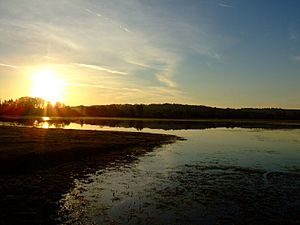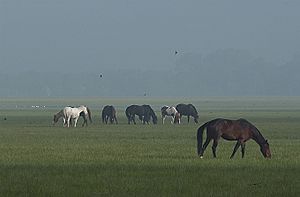Port Meadow, Oxford facts for kids
Quick facts for kids Port Meadow |
|
|---|---|
 Sunset over Port Meadow |
|
| OS grid reference | SP495085 |
| Civil parish |
|
| District | |
| Shire county | |
| Region | |
| Country | England |
| Sovereign state | United Kingdom |
| Post town | Oxford |
| Postcode district | OX2 |
| Dialling code | 01865 |
| Police | Thames Valley |
| Fire | Oxfordshire |
| Ambulance | South Central |
| EU Parliament | South East England |
| UK Parliament |
|
| Website | Oxford City Council |
Port Meadow is a huge open field next to the River Thames in Oxford, England. It's a special type of land called "common land," which means many people have the right to use it. It's mostly used for animals like horses and cows to graze, or eat grass.
About Port Meadow
Port Meadow is a very old place, used for grazing animals for thousands of years. People say it has never been ploughed, maybe for as long as 4,000 years!
A Gift from a King?
There's a cool legend about how Port Meadow became common land. It's said that Alfred the Great, a famous king, gave this land to the people of Oxford. This was a reward for helping to defend the kingdom against the Danes, who were invaders. The people who received this gift were called "Freemen" of Oxford. They were given the right to let their animals graze here for free.
This special right was even written down in the Domesday Book in 1086. The Domesday Book was a huge survey ordered by William the Conqueror to record land ownership in England. The Freemen of Oxford have used this right ever since! The name "Port Meadow" might even come from "Portman," an old word for a Freeman.
Where is it?
Port Meadow stretches along the east side of the River Thames. It runs from an area called Jericho all the way to Wolvercote. On its eastern side, you'll find the Cotswold Line railway, the Oxford Canal, and the area of North Oxford. To the west is the village of Binsey.
You can get to Port Meadow from different places. In the south, you can use Walton Well Road or Aristotle Lane. In the north, you can come from Godstow Road in Wolvercote.
A Special Place for Nature
Port Meadow is a typical "flood-meadow." This means it's a low-lying field that sometimes gets covered with water when the river floods, especially in winter. When it freezes over, it becomes a huge, safe place for ice skating!
In late spring, the meadow turns bright yellow with lots of buttercups. You'll often see horses, cattle, and geese grazing here. It's also a great spot for watching many different kinds of birds. Because of its special nature, Port Meadow is a Site of Special Scientific Interest. This means it's protected because of its important wildlife and geology.
At the southern end of the meadow, there's a small island in the River Thames called Fiddler's Island.
Burgess Field Nature Reserve
On the eastern edge of Port Meadow, you'll find Burgess Field. This area used to be a landfill site, but it has been cleaned up and turned into a nature reserve. It's managed by Oxford City Council. There's a circular path you can walk around, and it passes through some small groups of trees.
Fun Activities at Port Meadow
Port Meadow is one of the most popular places in Oxford for outdoor activities. People love to come here for:
- Walking
- Running
- Cycling
- Swimming in the River Thames
On sunny days, the riverbanks are often full of people enjoying the beautiful natural surroundings. It's also a favorite spot for photographers and people who love to watch birds.
History of Port Meadow
The River Thames, sometimes called the Isis in this area, flows right past Port Meadow. This river has been part of some famous stories!
Alice in Wonderland's Beginning
Did you know that the idea for Alice's Adventures in Wonderland started near here? On July 4, 1862, Reverend Charles Lutwidge Dodgson (who you might know as Lewis Carroll) and Reverend Robinson Duckworth were rowing up the river. They had three young girls with them: Lorina, Alice, and Edith Liddell. As they slowly rowed from Folly Bridge towards Godstow, the girls asked Dodgson to tell them a story. That's when he started making up the tale that later became the famous book!
Ancient Discoveries
Because Port Meadow has never been ploughed, it holds many old secrets underground. Archaeologists have found amazing things here, like:
- Several Bronze Age round barrows: These are ancient burial mounds from the Bronze Age.
- An Iron Age settlement: This shows where people lived during the Iron Age.
- Foundations of 17th-century forts: These were built during the English Civil War when Oxford was under attack.
Horse Racing and Wars
In the 1600s and 1700s, Port Meadow was used for horse racing. You can still see low stone bridges that were built over ditches for the races.
During the First World War, part of Port Meadow became a military airfield. The Royal Flying Corps used it to train pilots. Sadly, fifteen air crew members and pilots died flying from or near Port Meadow during that time. Later, in 1940, during the Second World War, a camp was set up on the meadow for soldiers who had been evacuated from Dunkirk.
In more recent times, in the 1980s and 1990s, Port Meadow was known for hosting free festivals and raves.
Nearby River Life
Just across the Thames from Port Meadow is Bossoms Boatyard, which has a small marina. You can also find the Medley Footbridge here, which crosses the Thames. The Medley Sailing Club, the furthest upstream sailing club on the River Thames, is on the western bank. To the south is the start of the Castle Mill Stream and Cripley Meadow, which has many allotments (small plots of land for growing food).
Changes and Development


Since 2012, Oxford University has been building student housing on the Castle Mill site. This site is very close to the southern end of Port Meadow, between the allotments and the railway tracks.
Concerns About the Buildings
The construction of these buildings has caused some debate. The new buildings are four to five stories tall and can be seen from Port Meadow. Many people were worried that they would spoil the beautiful views of Oxford from the meadow.
Groups like the Oxford Preservation Trust and the Green Party raised concerns. There was even an online petition and a "Save Port Meadow" campaign started in 2012. Some people compared the development to building a "skyscraper beside Stonehenge" because of its visual impact on such an historic landscape.
In 2013, Oxford City Council discussed with the university if the buildings could be made shorter. Later, the university made some changes to the buildings to try and make them blend in better with the surroundings.




